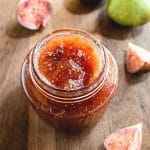
Homemade Fig Jam Recipe — Prepared, all natural, with fresh beautiful figs, without pectin, and with only 3 ingredients.
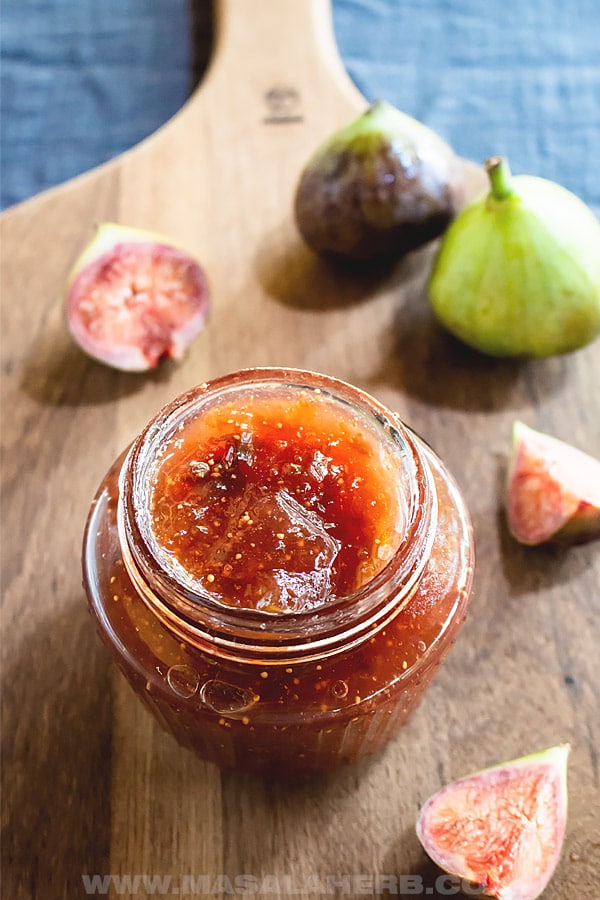

Global Food Recipes
with Spices and Herbs
Free E-Book available for a limited time. Grab yours now and get instantly inspired!
You missed out!
This is a French jam preserve recipe. AND get some inspiration with fig jam uses and ideas.
Do you like winter fruit jams, like the fig jam? The authentic Orange Marmalade, date jam and vanilla flavored Pear Preserves are my favorites!
Ingredient Notes
This fig jam recipe includes only 3 ingredients and is a French recipe.
Followed the traditional way of preparing this fig jam properly, and you will be rewarded with the real deal, quality fig jam.
That means, this fig jam is prepared with regular sugar and lemon juice. No artificial pectin sugar is used in this jam for various reasons. Pectin sugar has a distinctive taste and I just don't like it.
You can make out the pectin-sugar taste which overshadows the real fruit flavors that I oh so love in my homemade jams and this also the case in this fig jam.
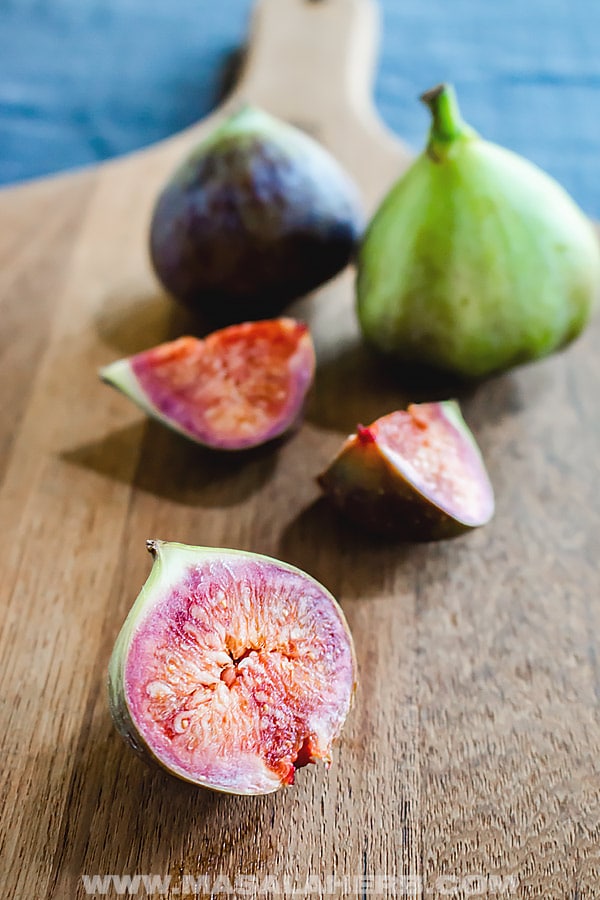
Sugar
A traditional French jam preserve recipe will always use only plain regular sugar. The type of sugar that everyone has at home lying around in the pantry.
Figs
For the figs, pick fresh not too soft and a little firm sweet fruits. Don't ever use figs that are turning bad, this would totally reduce the shelf live of your jam.
It's a big nono! Only use fresh figs.
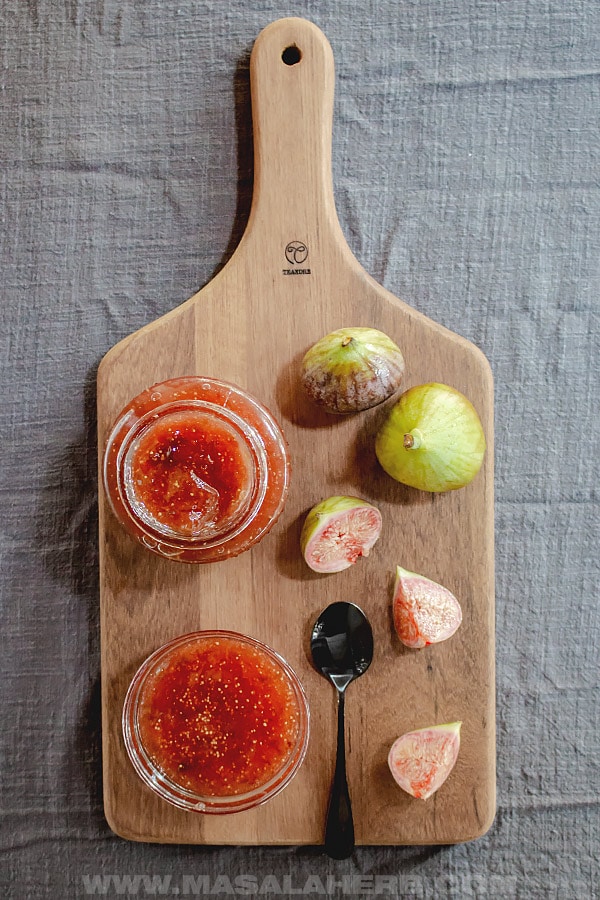
Lemon Juice
Lemon juice is added to the fig jam because figs contain less natural pectin then say apples or lingonberries.
The juice of a lemon contains some pectin, the highest amount of pectin is in the skin of a lemon.
I didn't add the lemon skin here to this recipe because you would need organic pesticide-free lemons and I didn't have that on hand.
However, feel free to add in whole pieces of lemon skin to add natural pectin to your jam. Take out the skin once the jam is set.
Process Overview
To make your own fig jam recipe, follow these 3 main steps.
Detailed instructions are in the recipe card further below.
Step 1
Wash your figs and cut off bad parts.
Cut your figs into quarters and place into your cooking pot with the sugar and lemon juice.
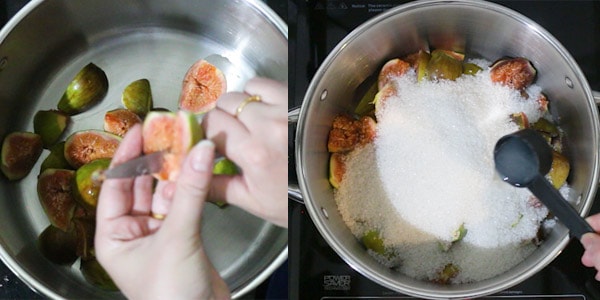
Step 2
Combine all the ingredients in the jam pot and bring to a rolling boil.
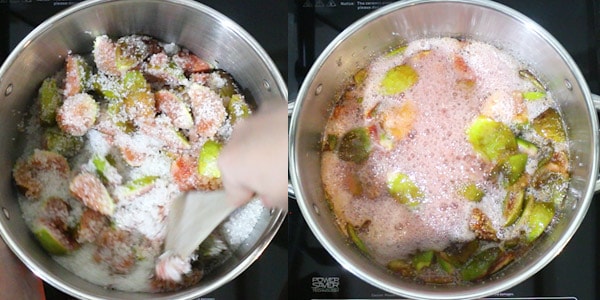
Step 3
Reduce the heat but cook while stirring occasionally.
Optional: Reduce the jam to a smooth consistency with a hand blender.
When the jam has reduced and looks translucent, test to see if the jam is set.
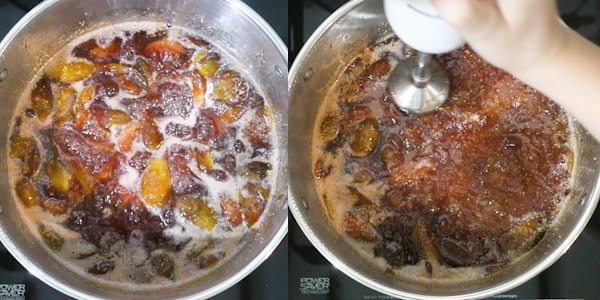
Step 4
Pour jam still hot into sterilized jars up to the rim, lock with the lids and turn upside down to create a vacuum.
Label jams and store in a cool and dry place until further use.
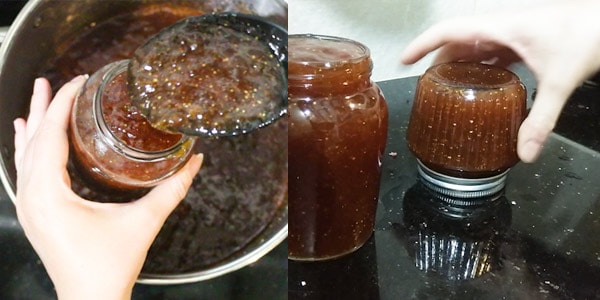
📖 Recipe
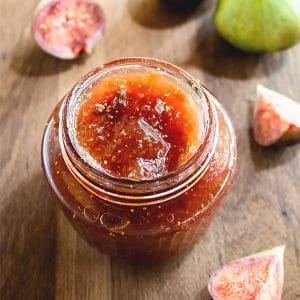
French Fig Jam Recipe
Instructions
- Wash your figs and pat dry.
- Keep a plate in the freezer (will use it later to test setting of jam). Clean and sterilize your jam jars and lids.
- Quarter figs and place into large jam cooking pot.
- Pour sugar over figs, as well as the lemon juice.
- Mix the fruits with the sugar and lemon juice.
- Keep on medium heat and bring to a rolling boil.
- Then reduce heat to a simmer, stir occasionally.
- Let the jam simmer until it's set. To test setting, either check with your thermometer, setting temperature 105 Celcius/220 Fahrenheit, and/or drop some jam on the ice cold plate and turn the plate a bit to see if the jam runs (watch my video). If it's not moving, your jam is set.
- Fill your clean jars with the jam up to the rim so that there is no air when you close the lid.
- Drop some rum or other alcohol onto the lid to kill any germs left.
- Wipe your jars clean, close with the lid tight and quickly turn the jam jars upside down to create a vacuum.
- Leave the jam jars upside down for about 24 hours. Then turn them.
- Keep your labels ready, mark with jam name and date. Stick on the jam jars so that you know what's in it.
- Store your fig jam in a cool and dry place. Once opened, store in the fridge only.
Notes
Nutrition
FAQs
Here I'm addressing some issues that can happen when your jam hasn't cooked properly, At the same time you can gather useful jam-making tips that I share within each question:
Why is my fig jam runny?
There are a few reasons why your fig jam can turn out runny.
You reduced the amount of sugar in the recipe because you thought it's too sweet and that it contained too much sugar.
The sugar is required is the major preservation agent in a jam, please don't reduce the sugar amount.
The recipe requires the exact amount of sugar to preserve the jam for the months to come.
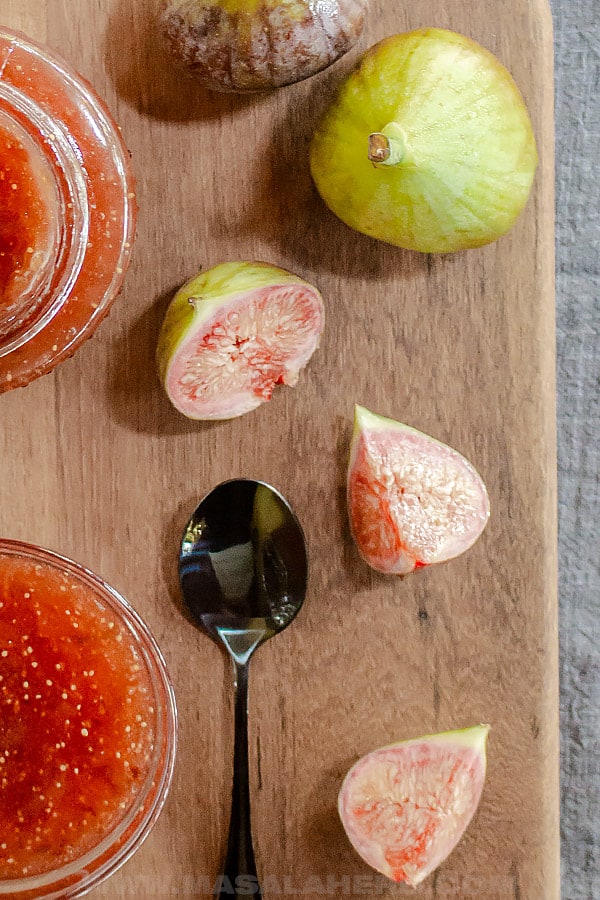
Besides, you will only use a teaspoon of jam on your breakfast bread or in your yogurt.
You didn’t give your jam a rolling boil or you didn’t cook your jam long enough. The jam setting temperature is 105 Celsius/220 Fahrenheit.
In that case, use a thermometer to help you get the temperature right so that your jam can set properly and doesn't turn runny. You used a pan that wasn’t giving uniform heating.
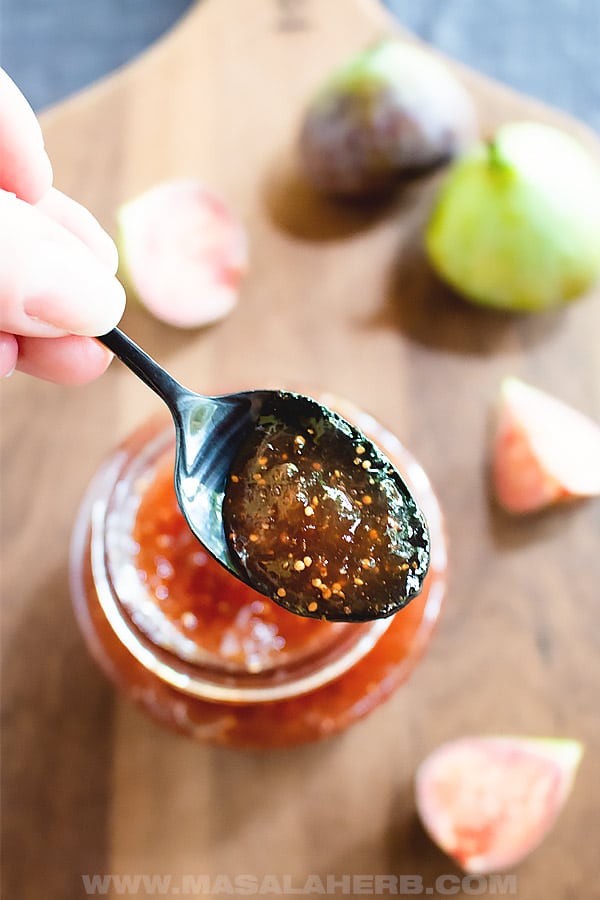
Some jam got cooked less, some too much. I recommend that you pick a stainless-steel pan or, even better, a French copper jam making pan.
A copper pan cooks the jam uniformly. Make sure to stir frequently too!
You doubled the ingredient amounts to make a bigger batch.
It’s easier to work with a batch of 1-kilogram (2 pounds) fruits, that's why all my jam recipes call only that much fruit.
Trying to jam more than a kilogram at a time can complicate things.
The sugar quantity would need to be adjusted and the more fruit the longer it needs to be cooked to set.
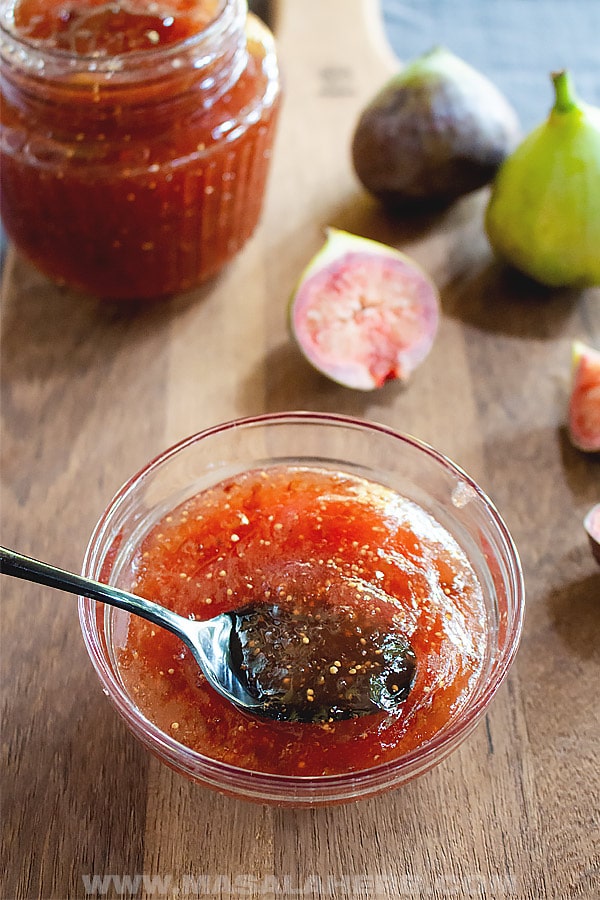
Easiest is to stick to a kilogram (2 pounds) of fruit at a time.
Keep in mind this is a recipe, doesn't call for artificial pectin.
This is a traditional French fig jam recipe. Artificial pectin is not added to French jams. Hence, why you shouldn't reduce the amount of sugar added to the jam.
Why is my jam too thick and hard?
The main reason why your fig jam has turned out hard is because you overcooked it, thinking it was still runny when hot or the jam was cooking on high heat.
Use a thermometer to know when the jam is set, and test on a freezer cold plate or spoon to check if it’s ready.
If it runs it needs some more cooking.
Keep in mind that jam will always appear liquid when it's hot.
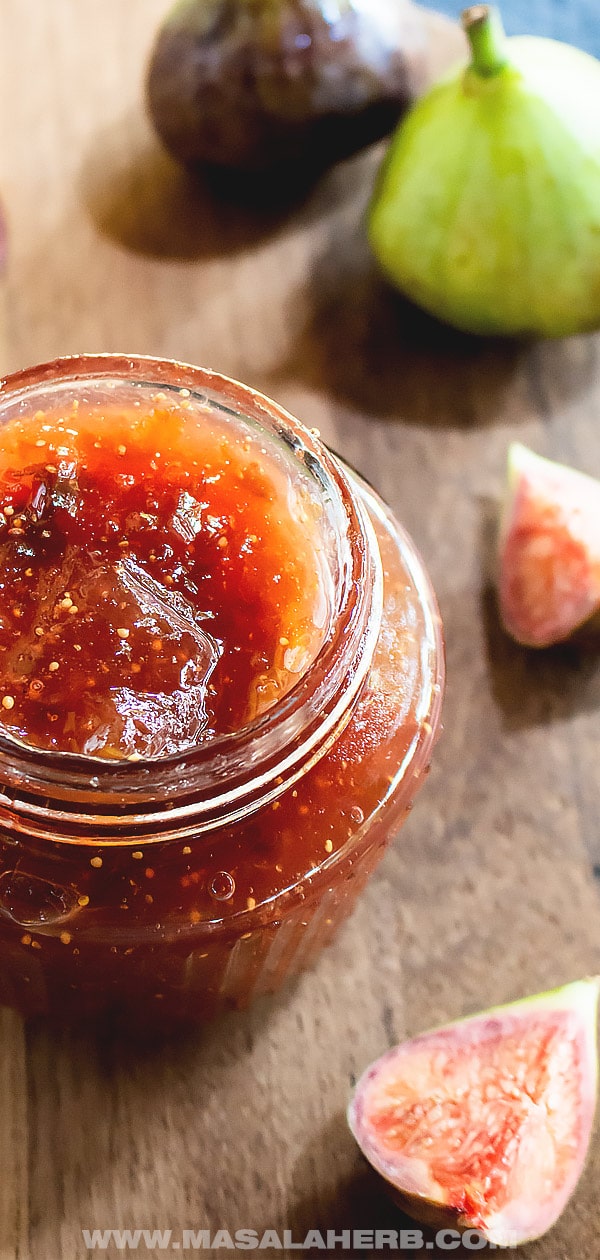
It gets thicker when it cools down. That's why the freezer cold plate comes handy because the hot drop of jam cools down instantly and that'when you know if your jam is good to be canned.
If you are afraid to try a fig jam without pectin, then please go ahead and pick a recipe with pectin instead.
We have never cooked a jam at home with pectin, so I can’t help you with that. In fact, my French mum sells her jams in the local farmers market in Austria.
What’s the setting temperature?
The perfect setting temperature for your fig jam is 220 Fahrenheit/105 Celcius.
Uses
Fig Jam is versatile and tastes great not only as a breakfast spread or dessert flavor addition but also used with savory food ingredients such as cheese.
Collect some fig jam uses and ideas below!
- Baked Brie with Fig Jam
- Fig Jam and Goat Cheese
- fig jam prosciutto Crostini
- Fig Balsamic Sauce by lemonsforlulu.com
- Fig Jam Vinaigrette
- Ham and Fig Jam Sandwich
- Fig Brie Walnut and Prosciutto Pizza by sidewalkshoes.com
- Yogurt with a dollop of Fig Jam
Tools
So, before you get into jam making, get the following jam making tools:
- large cooking pot — stainless-steel or preferable copper as it transmits the heat better
- wooden cooking spoon with a long handle so that you don't burn your fingers
- a plate in the freezer, so that you can test if the jam is set and not runny.
- Candy/Jam thermometer
- clean sterilized jars and lids
- a few drops of rum (or other alcohol) for the lids to disinfect further
- jam funnel (larger opening)
- canning tongs, jar lifter to take out the hot sterilized jars
- jam sticker labels to mention jam title and date
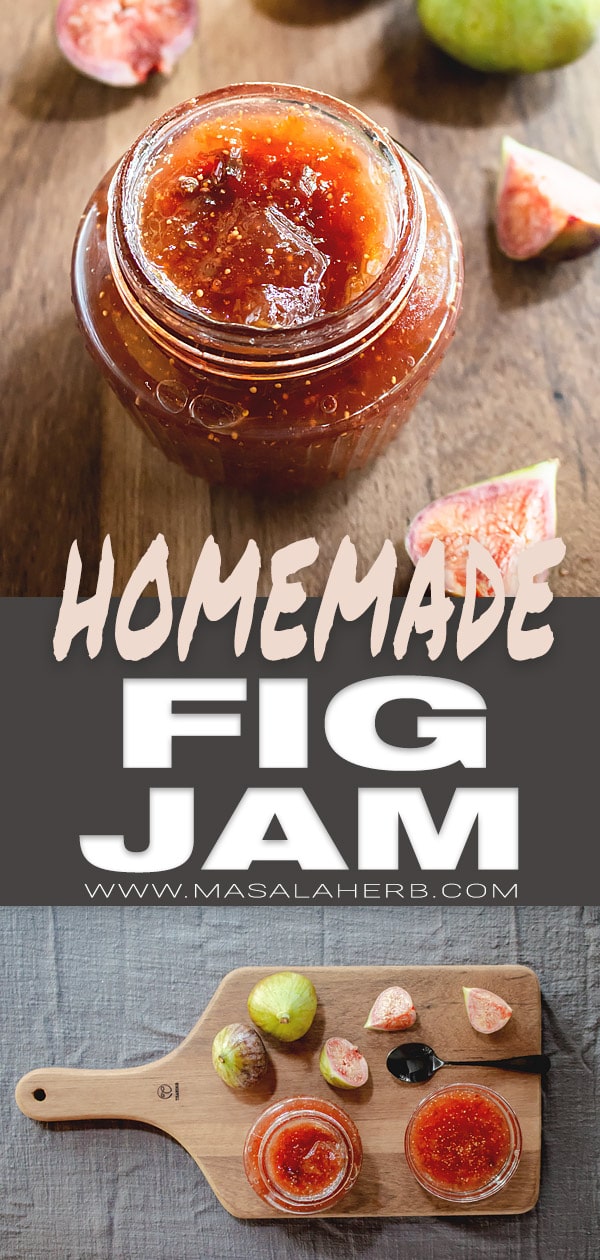

I was so pleased to read your recipe on Fig Jam. Thrilled to see how strongly you speak against pectin. I am 83 years old and been making jam for a long time and have never used pectin. I am Greek and use lemons all the time in all my cooking. I live in Australia and this Summer made white peach and Raspberry jam. I am sure you have made it if not do try it. It is delicious. Anyway must go and start my fig jam. Thank you. Take care. Olga 💜🩷💜
Thank you, Olga, for your kind comment. I think pectin changes the flavor, consistency and also the color. It makes the jam oddly cloudy, and it's not necessary if you make jam the way our ancestors did. I haven't tried mixing raspberry with peach yet. This will be on my to-do list this summer. Thanks for the inspiration, Olga. 🙂
Hello, i dont have a scale to weigh 1 pound of figs. Can you give me an idea how many figs roughly are in 1 pound. Thanks
Hi Patty, I'm afraid you will have to weigh to make a jam, and getting a kitchen scale is a great investment for your kitchen. The problem is that figs vary greatly in sizes and types, and even if they are the same size they won't be the same weight. Add to that the fact that varieties of figs are not always labeled in grocery stores. If you followed a recipe with a set count of figs, you will most probably fail because the weight ratio of sugar and fruits can make or break your jam. Too little sugar and your jam won't last and will get spoiled, too much sugar and it's too sweet.
How do I know how much my figs weigh for recipes if I don't have a scale? Thank you!
Hi Linda, I recommend getting a good quality kitchen scale, which can take at least 11 pounds (ca. 5 kg). If it has pounds and grams with an option to remove tara weight, that would be a good thing. Quality scales will show smaller weights too which can be useful if you need to weight fresh yeast, for example. A good kitchen scale can last years in a kitchen and can come handy in many ways.
It's important to weigh your ingredients when you prepare jams because a little too much or too little can make or break your jam and preservation period. That is why I recommend using a weight scale.
Had so many figs we froze the.Can frozen figs be used in this receipe?
Yes, you can use frozen figs to make this jam Glenn.
Helene,
We bought property that has a huge fig tree. I've never done anything with figs. Unfortunately, my figs are very ripe. They can not be cut because they are so soft. Can I still cook them into jam? After reading through your posting, the only negative that you mentioned was shelf life. I'm up to my eyeballs in figs and desperately searching for way to use them.
Hi Cindy, I think you can still use your overripe fruits. You can always "spoon" out the spoiled parts if there are any. I think your figs will make a fine jam. Hope this helps. PS: Lucky you!
Turned out greT
thanks for your feedback!
How much lemon juice per your recipe please was fixing to make it
Thanks
Hi Cathy, you can squeeze in the juice of one lemon.
I have a pint glass jars but no Lids. I brought plastic 2 cup containers with lids can I call the mixture down and add it to the plastic containers and if I do this how long will it last in the refrigerator
Yes, you can. I do that all the time too but with small leftovers, which don't fit into jars. So, I don't recommend doing it with the whole batch. You could freeze the jam in smaller batches in plastic jars. A small batch in a plastic jar keeps for at least 2-3 months in the fridge if kept in a clean cup with a lid. Be careful with contaminated spoons. Also, use only food-grade plastics with hot jams.
I have made 2 batches and went exactly by your measurements and cooking instructions. They tast wonderful but as so thick after opening the jar. It’s so thick it’s hard to get out of the jar. Any suggestions?
Hi Donna, If your jam is too thick after opening the jars, it means that you cooked it for too long. You can still use them though in pastries in fillings etc. You can try to take it back to the heat with a small quantity of water, mix and cook for 10 minutes or so. Bottle it again but this jam won't hold that long anymore but you can refrigerate it. Hope this helps. Next time you don't need to cook your jam that long. Jam always looks liquid when it's cooking hot so it can be misleading. Hence why I recommend testing with a cold plate if it's still running. The ice-cold plate cools down the hot drops of jam instantly and the real consistency comes through.
Would it be ok to sub cane sugar with Coconut sugar?
Do you mean with jaggery? I'm not sure if the jam will keep well if prepared with more natural sugars because the quality might vary. You can try it out and let us know how it worked out for you and how long the jam kept. 🙂
This might seem like a silly question, but Im new to canning. Is the lemon juice fresh or bottled and how much lemon is used?
Hi Tinna, that's a good question! I use fresh lemon juice all the time because that's what I get and it's natural. I don't know what's in bottled juice. I haven't tried using bottled lemon juice. You will have to evaluate if the one sold is of good quality and close to real lemon juice. If yes, I can imagine that it will do the trick too.
So delicious and easy. I made one jar with some free figs I exchanged for with my homemade pecan pesto. I added a lil more lemon juice, a lil less sugar and a pinch of salt, it turned out fantastically! Thx so much!
Hi there, awesome! Just be aware that reducing the sugar also reduces the shelf life. The sugar quantity fruit ratio was perfected for the best taste experience and so that it keeps over months without getting spoiled.
I added a dash of vanilla, because, why not! It's really good.
Great idea, will try that next 🙂
This came out perfect! Not too sweet & not too bland. I love how this is made with all natural ingredients. Thanks so much!
Makes me wonder if I could use the same recipe & substitute jalapeno peppers instead of figs? Any advice?
I made this today, it turned out perfectly. I am assuming that this is now shelf stable and does NOT require freezing. Please advise. Thank you, Terri
Hi Terri, if you followed all the jam-making details to the T (properly set jam) and used clean sterilized jars than your jam will be good unopened for at least 10 months. Store them in a dry and cool place on a shelf away from direct sunlight. Keep it in the fridge after opening and use within weeks.
The best and easiest recipe- loved it!
I made my organic fig jam today!!
Great, easy recipe 👌
Lovely! Glad to read that you enjoyed making the recipe.
We have a huge fig tree in our yard. We were excited to make something with them. This recipe was so easy and we loved that we didn’t have to use pectin! The jam is delicious!
Thank you so much for your feedback, I appreciate it! 🙂
I made this Jam. It turned out great. I used 6 pounds of ripe figs from my fig tree. The only difference was, I ran my figs through the food processor first, put in pot, added 5 cups of sugar and juice of3 lemons, boiled it down until it didn’t run on freezer cold plate. Jared as directed. Soooo good.
You have a fig tree! You are lucky. Thanks for sharing how you made it. I'm glad to read that you love your jam!
I cant Wait to make this!! If I want to use only 1 pound of figs do I just Cut the entire recipe in half or is there a different ratio?
Hi Nikki, yes just cut the recipe in half. The cooking time will be reduced too. Enjoy your jam! 🙂
Heaven in a bottle! Thank you for the instructions. I have never made jam before.
Thank you deb for your comment 🙂
So easy!! Doubled the recipe, used a little over 4 lbs of figs & cooked about 2-3 hrs. Immersion blended & put in little 4 oz jars. Put some leftover on toast & OMG! Will definitely make again!
Awesome! Thanks for sharing 🙂
Taste really good. Very easy. I doubled the batch. Used 10 cups of figs, cut in 8th’s, 7 cups of sugar, and 6 Tbls of lemon juice. Had to cook longer,
Awesome thanks for your feedback. Yeah when you double the batch, you have to cook it all longer until it sets. That's why I usually recommend the 2.2 pound/1kg quantity as it's easier to get it to setting point.
This is the perfect recipe I grew up with! It's delicious and the preserves or jam as they call it will last longer than a year if prepared properly. Delicious in cakes, on ice cream or spread on cheese and crackers. If you're like me..... Right out if the jar. Cookies are really delicious 😋😋😋💖💖👌
yeah in cakes! We use it like apricot jam on cakes before pouring over the glaze. My husband loves it with crema cheese and crackers 😀
I see it makes 3 jars, but what size jar? I was to make sure I prepare enough.
Hi Tesha, you will need about 3 8-ounce jars. You can use smaller or larger jars too.
Fantastic! Delicious but the best part was no water bath. Filled the clean jars to the top, put the lid and ring on and turned them upside down. Cleaned up the mess and could hear the lids “smuck” as they cooled. Waited overnight, turned them over and Voilà! All sealed and ready for the shelf! Thank You for easy to follow recipe! I will have fig jam when there is snow on the ground 🥰
Awesome! Enjoy your fig jam! 🙂
How long is jam usually good for? Expiration dates?
Your jam is good for about 10-12 months unopened but only if you worked clean with sterilized jars and if the jam has set propper. Keep in the fridge once opened and use up within 3 months. Keep in mind to use fresh fruits too. Semi damaged fruits will turn your jam bad quickly too.
We have had a fig tree for several years. It has always had figs, but they ripen a few at a time. This year it looks like we will have a large fig crop. Can I pick them a little under ripe and let them ripen inside the house on my counter?
Yes you can pick them slightly underripe and leave them to ripen further on your kitchen countertop. Just be aware that they ripen quickly, so store them in the fridge until further use once ripe.
This is the way we made fig preserves/jam all my life. My favorite ever is fig anything. I love to make Fig Cake! So delicious, especially with homemade figs ..yumm
Oh lucky you, all your life! I wish I had grown up with fig jam. 🙂
Do you really cook the fig skins?
yep, nothing wrong with the skin if you wash it properly. Fig skins are usually eaten in general, even raw. If you really feel you need to remove the fig skin then go ahead, but it's not necessary because the skin is so thin and fragile. Besides just cutting the fruit is faster.
Hmm! seem delicious. Hope my Son love it. He is a Fan of Jams and Jellies.
I love this fig jam! My sister had a fantastic crop of figs this year so I managed to get a few jars of jam for the winter. Your recipe works every time. Great post Helene!